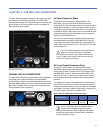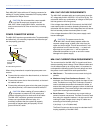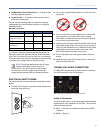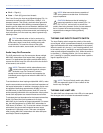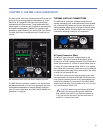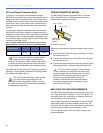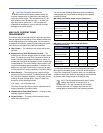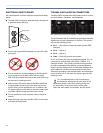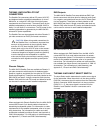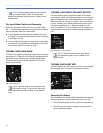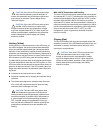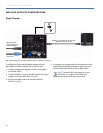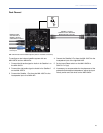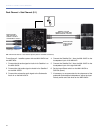
MM-10 OPERATING INSTRUCTIONS
27
CAUTION: The power source for the
MM-10ACX should always operate within the
required voltage range, at least a few volts from the
upper and lower ranges. This will ensure that AC volt-
age variations from the service entry — or peak volt-
age drops due to cable runs — will not cause the
subwoofer’s amplifiers to cycle on and off or cause
damage to the power supply.
MM-10ACX CURRENT DRAW
REQUIREMENTS
The current draw for the MM-10ACX is dynamic and fluctu-
ates as operating levels change. Since different cables and
circuit breakers heat up at varying rates, it is important to
understand the following types of current ratings and how
they affect circuit breaker and cable specifications.
■ Idle Current — The maximum rms current during idle
periods.
■ Maximum Long-Term Continuous Current — The
maximum rms current during a period of at least 10 sec-
onds. The Maximum Long-Term Continuous Current is
used to calculate temperature increases for cables, to
ensure that cable sizes and gauges conform to electrical
code standards. The current rating is also used as a rat-
ing for slow-reacting thermal breakers. In addition, the
Maximum Long-Term Continuous Current can be used
to calculate the AC looping capability of the MM-10ACX.
■ Burst Current — The maximum rms current during a
period of around one second. The Burst Current is used
as a rating for magnetic breakers. It is also used for cal-
culating the peak voltage drop in long AC cable runs
according to the following formula:
V pk (drop) = I pk x R (cable total)
The Burst Current can also be used to calculate the AC
looping capability of the MM-10ACX.
■ Ultimate Short-Term Peak Current — A rating for fast-
reacting magnetic breakers.
■ Inrush Current — The spike of initial current encoun-
tered when powering on.
You can use the following tables as a guide for selecting
cable gauges and circuit breaker ratings for the system’s
operating voltage.
The minimum electrical service amperage required by an
MM-10ACX subwoofer system is the sum of the Maximum
Long-Term Continuous Current for each unit. An additional
30 percent above the minimum amperage is recommended
to prevent peak voltage drops at the service entry.
NOTE: For the best performance, the AC cable
voltage drop should not exceed 10 V, or
10 percent at 115 V and 5 percent at 230 V. Make
sure that even with AC voltage drops that the AC
voltage always remains within the operating window.
!
MM-10ACX Current Draw with No Satellite Loudspeakers
Current Draw 115 V AC 230 V AC 100 V AC
Idle Current 0.21 A rms 0.20 A rms 0.23 A rms
Maximum Long-Term
Continuous Current
0.48 A rms 0.31 A rms 0.55 A rms
Burst Current 1.1 A rms 0.6 A rms 1.3 A rms
Ultimate Short-Term
Peak Current
2.2 A peak 1.6 A peak 2.5 A peak
Inrush Current 6.6 A peak 3.7 A peak 7.2 A peak
MM-10ACX Current Draw with Two MM-4XP Satellite
Loudspeakers Attached
Current Draw 115 V AC 230 V AC 100 V AC
Idle Current 0.32 A rms 0.26 A rms 0.36 A rms
Maximum Long-Term
Continuous Current
0.90 A rms 0.51 A rms 1.02 A rms
Burst Current 2.5 A rms 1.3 A rms 3.0 A rms
Ultimate Short-Term
Peak Current
4.5 A peak 2.8 A peak 5.0 A peak
Inrush Current 7.6 A peak 4.4 A peak 8.4 A peak



